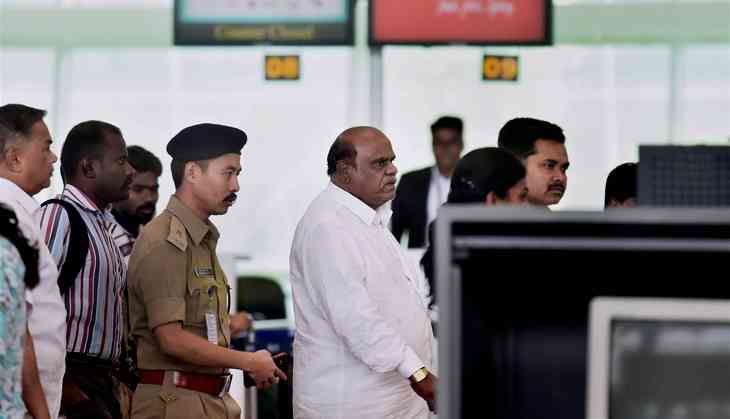End of the line? Karnan finally gets arrested & taken to Kolkata to serve his sentence

Calcutta High Court's retired judge CS Karnan was nabbed by West Bengal Police in Coimbatore on Tuesday. He was first taken to Chennai and then flown to Kolkata on Wednesday to serve the rest of his sentence.
Karnan has been on the run since 9 May when the Supreme Court sentenced him to six months' imprisonment for contempt.
The retired judge was picked up from a resort in Coimbatore, resisted arrest and told reporters that he was – “happy to be arrested for fighting corruption”.
The first serving judge to be jailed for contempt ever in India, Karnan retired earlier this month.
He claimed – “ I am a hero as I am the first sitting judge to fight corruption in the judiciary.”
A last-minute petition filed on his behalf by an advocate for a reprieve was rejected by the apex court.
What followed
Karnan's arrest and imprisonment followed an order by a seven-judge bench of the Supreme Court which held him guilty of contempt.
Chief Justice of India JS Kehar, who headed the bench, stated in the order that – “Justice Karnan is guilty of contempt of this court and the judiciary process of the gravest nature”.
The unprecedented action followed a letter that Justice Karnan had written to the Prime Minister’s Office (PMO) in January this year, alleging that 20 sitting and retired Supreme Court and high court judges were corrupt, including those in the Madras High Court where he served as a judge from 2009 till his transfer to the Calcutta High Court .
Taking strong exception to wild allegations, the apex court also said that the tenor of his letter was “scurrilous”.
However, before initiating contempt proceedings, the Supreme Court had taken measured steps to rein in the controversial judge.
First, he was transferred out of the Madras to the Calcutta High Court. When he exceeded his brief there as well, the apex court stripped him off all judicial functions.
Following this, the seven-judge bench summoned him to answer charges.
Appearing before the bench on 8 February, Karnan contended –
“The nature of the order clearly shows that upper caste judges are taking the law into their hands and misusing their judicial power against an SC judge with the mala fide intention of getting rid of him.”
Finding him defiant and unrepentant, the bench held that his sanity had to be tested to find out if he understood the gravity of the offence and was in a position to defend himself.
Karnan turned away the Kolkata Police which visited his residence with a psychiatrist. He refused to take a medical test, holding he was sane.
Go down fighting
When the seven-judge bench held him guilty, he challenged it by filing a writ petition, holding that the bench proceedings were void ab initio ( void from the very outset) as they had no jurisdiction to try a sitting judge.
He also challenged it on the ground that “no charge was framed” against him.
The court registry, however, refused to entertain the writ petition, holding that judicial proceedings were not amenable to writ jurisdiction under Article 32 of the Constitution.
After he was sentenced to six months imprisonment, Karnan made history by passing an order, holding all the seven judges guilty under the Scheduled Castes and Tribes (Prevention of Atrocities) Act, and sentencing them to five years of rigorous imprisonment.
He also ordered for non-bailable arrest warrants to be issued against them.
Caught on the offensive
This hardened the stand of the bench.
It refused to entertain subsequent petitions filed on Karnan’s behalf by a lawyer seeking that the order against him be revoked. While on the run, Karnan even sought the intervention of the President to get the sentence suspended. That was also ignored.
Karnan's basic contention was that the judges were appointed by the President and they could, therefore, only be removed from office through impeachment proceedings which would lead to the President withdrawing his pleasure.
Suffering from a persecution complex, Karnan from the very onset went public with allegations against fellow judges of the Madras High Court and said that he was being discriminated against because he was a Dalit.
In 2011, he even wrote to the National Commission for Scheduled Castes and Tribes, he claimed that he was being harassed by his professional brethren.
The whole episode brought to the fore the question – how was such a man elevated to the bench in the first place under the collegium system (under which judges appoint judges)?
Karnan was elevated in May 2009 on the basis of the recommendation of the then Chief Justice of Madras Sanjay Kishan Kaul.
Yet, Karnan initiated suo motu contempt proceedings against Kaul in April 2015 on the grounds that he was giving him only “dummy portfolios”.
The proceedings were later stayed by the Supreme Court.
Karnan was then transferred to the Calcutta High Court in February last year after he accused Kaul of corruption. When the apex court stayed his order, he apologised saying he had lost his “mental balance”.
He finally took charge as a judge of Calcutta High Court after a meeting with the then Chief Justice of India, Justice JS Thakur.
When he showed no judicial restraint even in his new post, the law finally caught up with him.
Karnan let his guard down after he retired on 12 July, believing that the bench might take a lenient view.
However, when senior Supreme Court lawyer KK Venugopal mentioned before the bench that the judge was due to retire shortly and he might be let off, the judges were firm that he had to face the punishment whether he was sitting or retired.
The only option before the judge now is to serve his term, hoping that apex might remit the sentence.
Edited by Jhinuk Sen
First published: 21 June 2017, 16:55 IST
